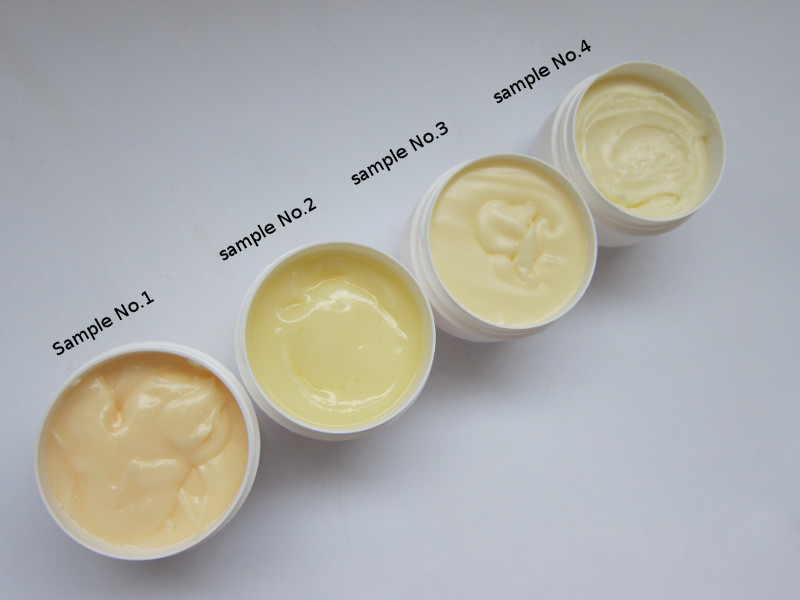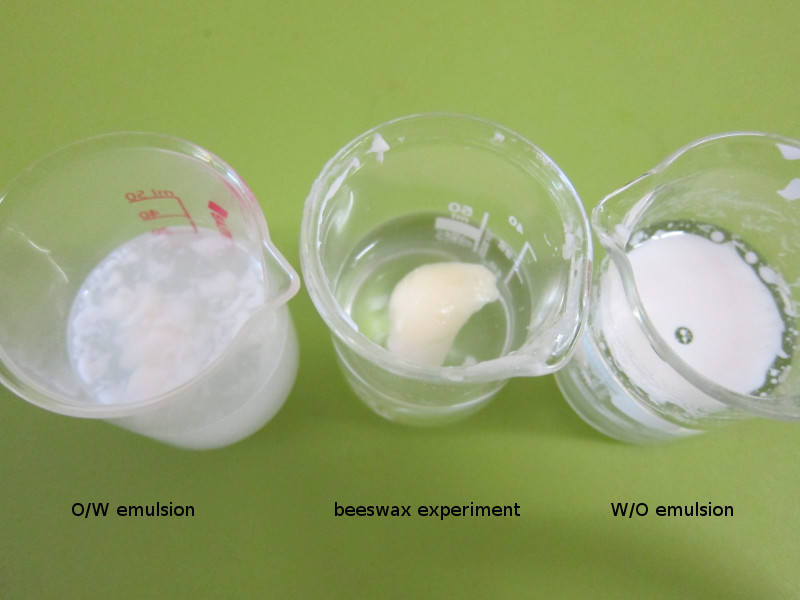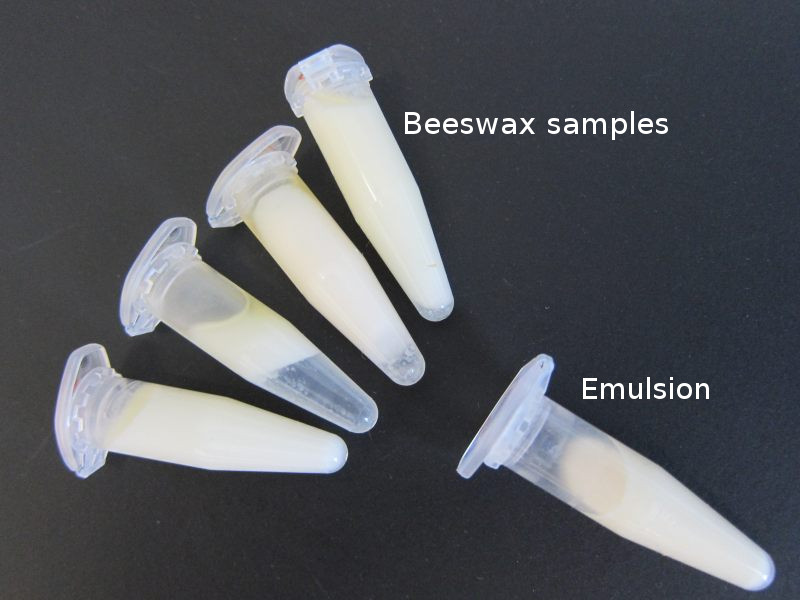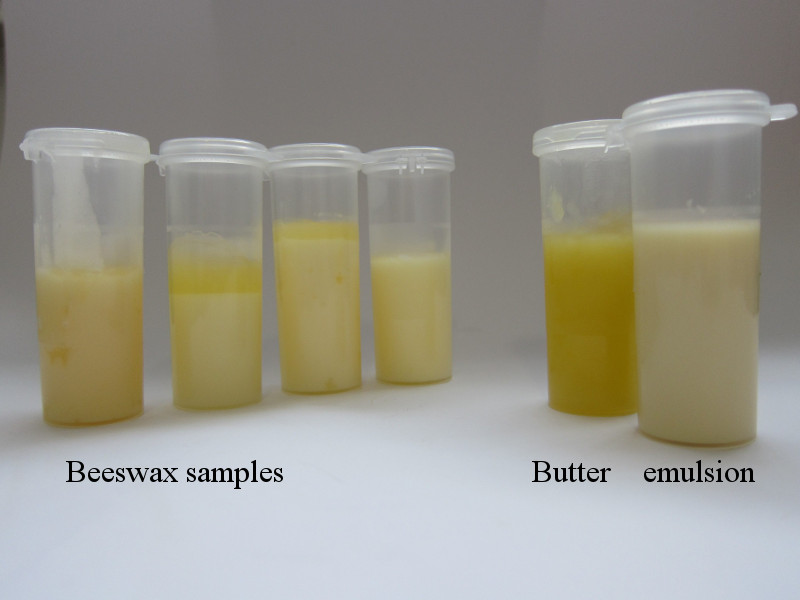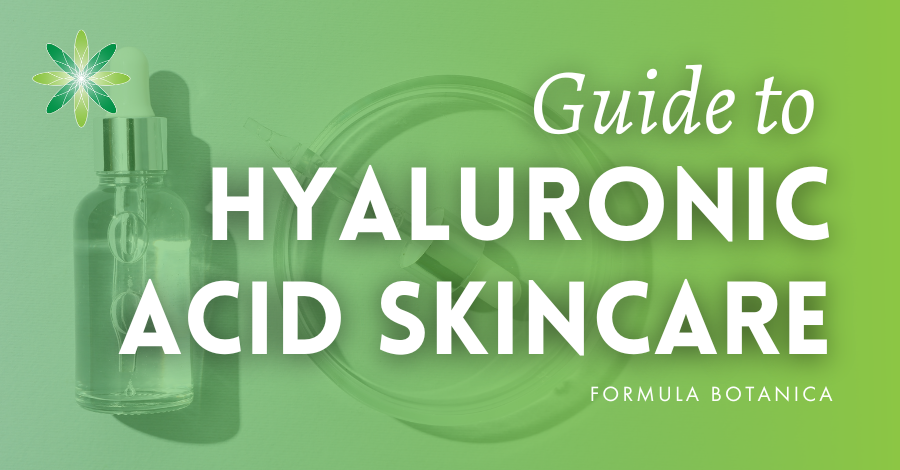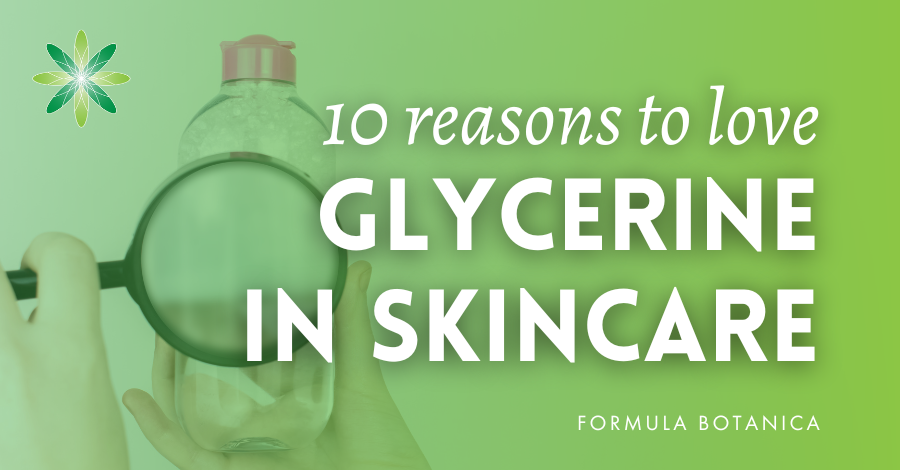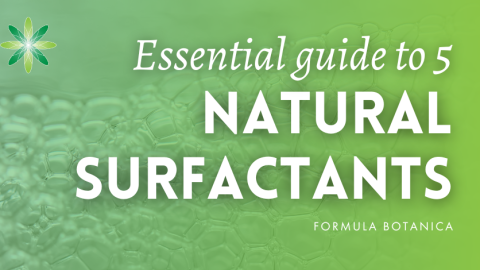Beeswax is a fabulous cosmetic ingredient and is much praised in the natural cosmetic community as an emollient, for its healing and soothing properties, for the beautiful colour it imparts to balms and butters and, much to every chemist’s disappointment, as a natural emulsifier. Unfortunately though, beeswax is not an emulsifier.
Indeed beeswax is one of the oldest cosmetic ingredients in our history. It has been used for more than a thousand years in balms and even decorative cosmetics. It is still being used by modern (non-vegan) herbalists as a base for their balms and butters. Beeswax is even praised in the conventional and mainstream cosmetic and pharmaceutical industries, although they attach it to PEG for better performance, water solubility, non-greasy skin feel, emulsion stability , etc.
Beeswax imparts a lovely skin feel and a nice colour to balms and butters, hardness to lipstick and kajal formulations and improves the thermal stability of butters. What it does not do however, is work as an emulsifier.
Beeswax + Borax
The only and only way beeswax functions as an emulsifier (and you can read it in old cosmetic science and formulation books) is in combination with borax. Borax, also called sodium borate or tetrasodium borate, has been used for decades both in homemade DIY recipes and also at an industrial scale, in combination with beeswax, to emulsify oils and butters in both oil-in-water and water-in-oil formulations.
Borax, which is an alkaline material, saponifies beeswax to soap. So it’s not the beeswax by itself that is the emulsifier, it’s the resulting soap. This means that, without borax, beeswax is not an emulsifier at all and needs to be emulsified in lotions and creams just like any other lipophilic (oil-loving) ingredient.
We have however found that there are quite a lot of natural DIYers claiming that beeswax does work as an emulsifier. You can find their DIY beeswax emulsion recipes on blogs, books, eBooks, and even workshops. Many of these DIY recipes are not preserved and are formulated with ingredients that run the risk of enhancing contamination, such as honey, aloe vera and unpreserved hydrosols.
Borax is a mineral (natural, ha?), it is soluble in water and it has been in use for centuries. It has many industrial applications which are out of the scope of this blog post. It was used as a detergent aid, in home cleaners, in hair care products, oral care products, as a buffering agent and also together with beeswax as an emulsifier.
Borax is however considered to be a carcinogenic ingredient and its applications are limited in the EU and some other regions of the world (CMR class 1B). As you see, not everything natural is entirely safe.
We put DIY Beeswax ‘Emulsions’ to the test
It seems that by banning borax, every hope for the application of beeswax as an emulsifier is lost. There are however, formulators and DIYers who still advocate application of beeswax as an emulsifier. We have seen beeswax ’emulsions’ sold all around the world. We have even spoken to formulators who claim very long-term stability (>10 years) for their beeswax ’emulsions’.
Rather than us refute these claims with theory to prove that beeswax is not an emulsifier, we decided to put the emulsions to the test. I duplicated four online recipes from well-respected bloggers. Between them, these recipes have been shared up to 25,000 times on Pinterest, Instagram or Facebook. It is safe to assume that these recipes have been duplicated at least a couple of thousand times.
I followed the recipes and instructions. I replaced all hydrosols and infusions in the recipes with freshly boiled distilled water, I added a preservative (because nothing in my lab is blended without a preservative) and I converted spoons, drops and cups into percentages as correctly as I could figure out and convert. I also omitted the essential oils. The most important factor in replicating these recipes is achieving the correct ratio of water to oil, and this I managed to achieve exactly as the authors instructed.
Beeswax ‘Emulsion’ Formulation Fail: No. 1
Please note that this is not a formulation we support or teach and we do not recommend that you copy this formulation at home – we tested this beeswax ’emulsion’ to demonstrate that beeswax is not an emulsifier.
Phase A
- Distilled water 36.0%
Phase B
- Beeswax 9.0%
- Organic cocoa butter 9.0%
- Organic sweet almond oil 45.0%
Phase C
- Preservative 1.0%
Procedure:
- Heat Phase A and B separately in a water bath.
- When all of phase B is melted stop heating and add the water phase to the oil phase under stirring. Blend.
- Cool down and at approx. 35-40 degrees Celsius add the preservative.
- Continue stirring until the blend reaches the room temperature.
- Fill in a jar.
Beeswax ‘Emulsion’ Formulation Fail: No. 2
Please note that this is not a formulation we support or teach and we do not recommend that you copy this formulation at home – we tested this beeswax ’emulsion’ to demonstrate that beeswax is not an emulsifier.
Phase A
- Distilled water 46.0%
- Organic glycerine 1.6%
Phase B
- Organic sweet almond oil 32.0%
- Organic coconut oil 14.0%
- Beeswax 4.6%
Phase C
- Tocopherol 0.8%
- Preservative 1.0%
Procedure:
- Heat Phase A and B separately in a water bath.
- When all of phase B is melted stop heating add the water phase to the oil phase under stirring. Blend.
- Cool down and at approx. 35-40 degree Celsius add the preservative and tocopherol.
- Continue stirring until the blend reaches the room temperature.
- Fill in a jar.
Beeswax ‘Emulsion’ Formulation Fail: No. 3
Please note that this is not a formulation we support or teach and we do not recommend that you copy this formulation at home – we tested this beeswax ’emulsion’ to demonstrate that beeswax is not an emulsifier.
Phase A
- Distilled water 41.0%
Phase B
- Beeswax 6.7%
- Organic sweet almond oil 41.0%
- Organic poppy seed oil 10.3%
Phase C
- Preservative 1.0%
Procedure:
- Heat Phase A and B separately in a water bath.
- When all of phase B is melted stop heating and add the water phase to the oil phase under stirring. Blend.
- Cool down and at approx. 35-40 degree Celsius add the preservative.
- Continue stirring until the blend reaches the room temperature.
- Fill in a jar.
Beeswax ‘Emulsion’ Formulation Fail: No. 4
Please note that this is not a formulation we support or teach and we do not recommend that you copy this formulation at home – we tested this beeswax ’emulsion’ to demonstrate that beeswax is not an emulsifier.
Phase A
- Distilled water 46.0%
Phase B
- Organic sweet almond oil 45.8%
- Beeswax 7.2%
Phase C
- Preservative 1.0%
Procedure:
- Heat Phase A and B separately in a water bath.
- When all of phase B is melted stop heating and add the oil phase to the water phase under stirring. Blend.
- Cool down and at approx. 35-40 degrees Celsius add the preservative.
- Continue stirring until the blend reaches the room temperature.
- Fill in a jar.
Why Beeswax is not an Emulsifier
Let’s first of all analyse the four recipes we just followed:
1. In three of these formulations, the water phase is added to the oil phase and only in one of them is the oil phase added to the water phase.
2. In all four cases, high shear is used to create the ’emulsion’ (or better put: the blend produced by mixing the water and oil phases together). The authors either used a stand-mixer or a stick blender to blend oil and water phases.
At Formula Botanica, we recommend that students start making small volumes of an emulsion (30-50 ml) and initially blend them with a spatula or a hand whisk. When the emulsifier is efficient and dosed correctly, usually even manual blending with a glass rod or spatula is enough to create an emulsion. The emulsion is certainly not as stable as an emulsion made with a hand blending instrument such as Blendia or a professional homogeniser but should at least remain stable at room temperature for a couple of weeks (up to a few months).
In all of these 4 pseudo-emulsions, no emulsion is formed by manual blending of oil and water phase. The oil phase remains stubbornly on top of the water phase and resists blending with the water phase. This is a clear sign that there is nothing in the oil phase to reduce the interface tension between oil and water. In other words, there is no emulsifier present in the blend. The classic definition of emulsification is the blending of two immiscible liquids such as oil and water, so that one liquid is dispersed as fine droplets in the other liquid.
Beeswax is not an emulsifier - read @FormulaBotanica's experiments to learn why. #CosmeticScience Share on X
Stability Testing our Beeswax ‘Emulsions’
Let’s now have a look at some of the photos of our results:
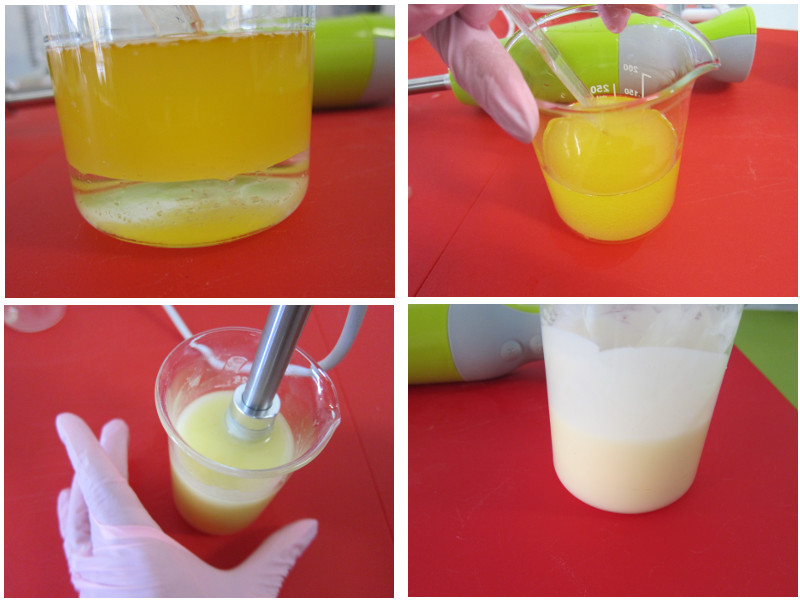
In this photo, you can see that our oil and water phases were added together and blended with a spatula – if beeswax were a proper emulsifier then this would be sufficient to create a short-term stable emulsion. However, we then had to further blend the mixture with our handheld homogeniser to achieve an emulsion-like appearance and consistency
In this photo you can see all of the samples after 48 hours of storage at room temperature. They all have slightly different textures and colours. But they all look lovely and feel nice and smooth over skin. So far, so good.
Dispersing Emulsions in Water
We usually measure the pH of an oil-in-water emulsion at the end of the emulsification process and before adding the preservative. For this purpose, a 10% dilution of the emulsion in distilled water is prepared. All 4 samples did not blend with water at all and built a clump on top of the water.
In this photo you can compare the behaviour of an oil-in-water (O/W) emulsion with a water-in-oil (W/O) emulsion and with this beeswax experiment. All of the four beeswax ’emulsion’ samples we prepared didn’t blend with water. This means that if we had to compare this beeswax blend to an emulsion, it would be a W/O emulsion (even for the sample where the oil phase is added to the water phase).
Centrifuge testing
One of the standard tests in our laboratory is centrifuge testing. Samples of the emulsion (or shampoo or conditioner etc.) are rotated for 15 minutes at 4000 rpm speed. This test is one of the routine stability tests for cosmetic products (note – if you want to learn to understand and undertake stability tests, we teach our Certificate in Cosmetic Stability Testing).
Centrifuge testing doesn’t always provide the formulator with representative results. Some emulsifiers do not respond to this test. If the sample passes the centrifuge test (i.e. there is no separation), it is highly probable that the sample will remain stable for a long period. If it doesn’t pass the test, it doesn’t necessarily mean that it wouldn’t remain stable. Since we apply this test for all samples made in our lab (except for balms and butters), we ran the test for these beeswax formulations as well. All 4 samples failed but because of our previous experience, we decided not to immediately conclude that the beeswax samples were unstable.
This photo shows the beeswax samples together with a stable emulsion after centrifuging. All beeswax samples have separated, whereas the emulsion is intact.
Thermal Stability Testing
The most strange result we observed was the behaviour of the samples at elevated temperature. Usually during our thermal stability tests, emulsions and other water-containing products (such as a shampoo, conditioner, tonic or micellar water) are stored at 4 oC, at room temperature and at least at one elevated temperature. In our lab this elevated temperature is 45 oC.
Obviously butters melt partially or totally at this temperature (depending on the melting point of the butters and waxes) and they solidify again after coming back to room temperature. Stable emulsions remain stable up to (at least) 8 weeks at 40-45 oC. The viscosity is reduced by storage at an elevated temperature but the structure of the emulsion should remain the same. Only after passing the thermal stability test, can we release a sample as stable.
All of the beeswax samples started separating after just a couple of hours at 45 oC. They do not melt completely like a balm or butter and do not remain intact like a stable emulsion.
In this photo you can see the beeswax samples after 5 hours in the oven together with a balm (which is completely melted) and an emulsion which was kept in the same oven for 6 weeks.
Whereas a balm or butter solidifies after coming back to room temperature, these beeswax samples remained non-homogeneous and separated after being kept at room temperature (after they were removed from the 45 oC oven) for 48 hours. The separated phases do not blend spontaneously.
This photo shows the beeswax emulsions together with a beeswax containing balm and a beeswax-free butter after they were removed from the oven and kept at room temperature. You can see that the beeswax samples are all showing clear signs of separation.
In this photo, we’ve taken a close-up image to show you the separation is shown in the beeswax samples.
Conclusion: Why Beeswax is not an Emulsifier
As every chemist could have predicted, any ’emulsion’ made with beeswax (and not borax) is not an emulsion. It doesn’t behave like an emulsion and it doesn’t even behave like a butter. Water is trapped in the blend only by applying high mechanical force and due to the high viscosity that beeswax provides. Upon heating, the blend separates and won’t come together again by cooling.
Even if these results might not be of interest for hobbyists and DIY recipe followers who wish to make a nice and natural emulsion and use it up in a couple of weeks, this suggested blend of oil, beeswax and water doesn’t work the way an emulsion works. An emulsion is a fine dispersion of oil droplets in water (these are the most common emulsions) or fine droplets of water in oil.
In an emulsion, the active ingredients, humectants and applied cosmeceuticals and plant oils are gradually released to the skin providing the skin with both lipophilic (oil loving) and hydrophilic (water loving) ingredients. This beeswax pseudo-emulsion is not capable of releasing any humectants to the skin and is not even as effective as a plain butter or balm.
There is nothing wrong with blending together different oils, waters and beeswax for DIY recipes (as long as you correctly and safely preserve your blend). However, these types of products are not emulsions because beeswax is not an emulsifier. All you have to do is undertake some simple stability testing and you will see these results for yourself.
One Final Note on Preservation
The DIY recipes we found online generally didn’t contain a preservative, which is worrying given the huge number of times that these recipes have been shared. If your product contains water or comes into contact with water, always make sure that you use a safe preservative at the correct dosage. Contamination can endanger you, your customer, your products and your business. Cosmetic preservation is a necessity.
Further reading on emulsification, stability testing and preservation:
- 17 Points to consider when choosing an Emulsifier
- 4 Signs of Cosmetic Instability
- When even phenoxyethanol fails: The Liz Earle Recall
- Can cosmetics kill you?
Have you ever prepared a beeswax emulsion? Did it remain stable for you?
FREE TRAINING
Learn how to become an
Organic Skincare Formulator
FREE TRAINING
How to become an
Organic Skincare Entrepreneur
FREE TRAINING
How to become an
Organic Skincare Entrepreneur
Leave us a comment

Dr. Elham Eghbali was Formula Botanica’s Cosmetic Chemist between 2014 and 2018. She has over 20 years’ industry experience and is based in Bavaria, Germany. To read more about Formula Botanica’s team, visit our staff page.


